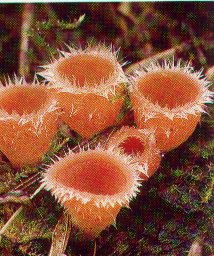Ascomycota Archive
The principle behind the leavening of bread dough by baker’s yeast is the same as in brewing, i.e. the anaerobic metabolism of glucose and other reducing sugars via pyruvic acid into ethanol and CO2. The difference is that the released …
Types of fruit body: There are number of fruit bodies in Ascomycota. In yeasts and related fungi the asci are not enclosed by hyphae, but in most ascomycetes they are surrounded by hyphae to form an ascocarp or ascoma. An old term for …
In many ascomycetes, studies of the fine structure of asci during cleavage of the ascospores have shown that a system of double membranes continuous with the endoplasmic reticulum extends from the envelope of the diploid fusion nucleus. The double membrane …
In yeasts and related fungi, the ascus arises directly from a single cell, but in most other ascomycetes it develops from a specialized hypha, the ascogenous hypha, which in turn develops from an ascogonium. Ascogenous hypha The ascogenous hypha of …
About 10-�16 species of Saccharomyces are currently recognized. We will focus on S. cerevisiae, which in many ways is the most important fungus yet discovered. About 25 strains of S. cerevisiae exist, and these have different physiological properties which are relevant …
Conidia: The asexual spores or conidia of ascomycetes are remarkably diverse in form, structure and modes of dispersal, but their development or conidiogenesis occurs in a limited number of ways. The cell from which a conidium develops is the conidiogenous …
Sexual life cycles: Sexual life cycles in the strict sense, i.e. involving nuclear fusion and meiosis, occur only in those ascomycetes which possess asci, because it is within the young ascus that these events occur. Ascospores of most ascomycetes contain one …
The phylum Ascomycota (colloquially called ascomycetes) is by far the largest group of fungi, estimated to include more than 32000 described species in 3400 genera. It is assumed that the majority of ascomycetes has yet to be discovered, and the …
